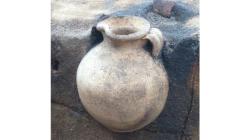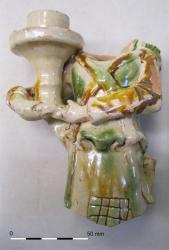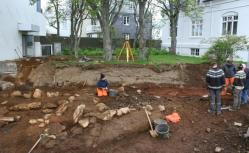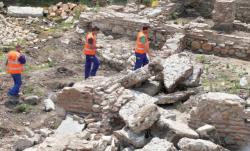INSTITUT SUPERIEUR D'ANTHROPOLOGIE
INSTITUTE OF ANTHROPOLOGY
ONLINE COURSES / COURS A DISTANCE
FALL TERM : OCTOBER 2015
REGISTER NOW
DANEMARK –  Ribe - Ribe’s archaeology never ceases to surprise, and now teams from the University of Aarhus and Sydvestjyske Museum have made yet another unique find during excavations in the city’s oldest burial ground. Half a metre underground in a parking lot, wedged between other urns and tombs, they have discovered a perfectly intact French wine pitcher, which is predicted to be around 1,000 years old. “It is a unique find,” said Morten Søvsø, the head of archaeology at Sydvestjyske Museum. “The pitcher is an example of the finest pottery produced in northern Europe at the time, and it has never been seen before in Denmark. The vessel reveals information about the vast trading network that put Ribe on the map during the Viking era.” “Ribe is the oldest city in Scandinavia, and we often excavate at the city’s ancient burial ground to find out more about our ancestors in the north,” Søren M Sindbæk, a professor of medieval and Renaissance archaeology, told Ekstra Bladet. The pitcher is what is referred to as a trefoil jug, made in France or Belgium during the time of the Merovingian dynasty (about 450-750 AD). “The jug is a masterpiece from the French or Belgian workshops, and its elegant form is a direct legacy from ancient Roman potters. No pottery at home could technically produce such a thing at the time,” said Søvsø.
Ribe - Ribe’s archaeology never ceases to surprise, and now teams from the University of Aarhus and Sydvestjyske Museum have made yet another unique find during excavations in the city’s oldest burial ground. Half a metre underground in a parking lot, wedged between other urns and tombs, they have discovered a perfectly intact French wine pitcher, which is predicted to be around 1,000 years old. “It is a unique find,” said Morten Søvsø, the head of archaeology at Sydvestjyske Museum. “The pitcher is an example of the finest pottery produced in northern Europe at the time, and it has never been seen before in Denmark. The vessel reveals information about the vast trading network that put Ribe on the map during the Viking era.” “Ribe is the oldest city in Scandinavia, and we often excavate at the city’s ancient burial ground to find out more about our ancestors in the north,” Søren M Sindbæk, a professor of medieval and Renaissance archaeology, told Ekstra Bladet. The pitcher is what is referred to as a trefoil jug, made in France or Belgium during the time of the Merovingian dynasty (about 450-750 AD). “The jug is a masterpiece from the French or Belgian workshops, and its elegant form is a direct legacy from ancient Roman potters. No pottery at home could technically produce such a thing at the time,” said Søvsø.
http://cphpost.dk/news/archaeologists-find-1000-year-old-pitcher-in-jutland.html
ROYAUME UNI –  Salisbury - An unusual ceramic object came up recently from a site just outside Salisbury. The site itself is enigmatic – it is rectangular in outline with ‘bastions’ at the corners, and looks just like a classic fort, except that it consists only of a shallow ditch, with no structural remains at all, and no internal features. Whatever it was, it was very ephemeral. The suggestion is that it is some kind of very temporary military construction – but what date is it? There are practice trenches from the First World War close by, but this is clearly older. This object is the only find made from the ditch, apart from a few pieces of abraded medieval roof tile, which is ubiquitous in the fields around Salisbury. The object is in the form of a female figurine, holding the candleholder in her right arm; the head and base of the figure are missing. It is made of a pale red clay, covered in a white slip and a clear lead glaze mottled with green and brown. Slipwares were made at various centres across the West Country in the 17th and 18th centuries, for example at Donyatt in Somerset, but expert opinion suggests that this object is more exotic. The most likely source is France, and the date probably 17th century, although no direct parallel has yet been found. Our investigations continue, but one burning question remains – what was an elaborate imported candlestick like this doing on a 17th century, perhaps Civil War, military site in Wiltshire?
Salisbury - An unusual ceramic object came up recently from a site just outside Salisbury. The site itself is enigmatic – it is rectangular in outline with ‘bastions’ at the corners, and looks just like a classic fort, except that it consists only of a shallow ditch, with no structural remains at all, and no internal features. Whatever it was, it was very ephemeral. The suggestion is that it is some kind of very temporary military construction – but what date is it? There are practice trenches from the First World War close by, but this is clearly older. This object is the only find made from the ditch, apart from a few pieces of abraded medieval roof tile, which is ubiquitous in the fields around Salisbury. The object is in the form of a female figurine, holding the candleholder in her right arm; the head and base of the figure are missing. It is made of a pale red clay, covered in a white slip and a clear lead glaze mottled with green and brown. Slipwares were made at various centres across the West Country in the 17th and 18th centuries, for example at Donyatt in Somerset, but expert opinion suggests that this object is more exotic. The most likely source is France, and the date probably 17th century, although no direct parallel has yet been found. Our investigations continue, but one burning question remains – what was an elaborate imported candlestick like this doing on a 17th century, perhaps Civil War, military site in Wiltshire?
http://www.wessexarch.co.uk/blogs/news/2015/06/12/civil-war-candlestick?utm_source=feedburner&utm_medium=feed&utm_campaign=Feed%3A+wessexarchaeology+%28Wessex+Archaeology%29
YEMEN – Sana'a - Saudi-led airstrikes targeting Houthi strongholds destroyed historic houses in the Old City of Sana’a, a UNESCO world heritage site. At least five civilians were killed and others buried under the rubble, medical officials and witnesses said. The Old City has been inhabited for nearly 2,500 years and has a high density of unique ochre and white, mud-brick, tower houses, labyrinthine souqs, mosques and hammams. UNESCO condemned the bombing, noting that historical buildings, monuments, museums and archaeological sites across the country had all suffered since the start of the conflict. "I am profoundly distressed by the loss of human lives as well as by the damage inflicted on one of the world's oldest jewels of Islamic urban landscape," UNESCO's Director General Irina Bokova, said in a statement on the agency's website
http://www.atlanticcouncil.org/blogs/menasource/top-news-unesco-heritage-site-destroyed-in-sana-a
ISLANDE –  Reykjavík - An archaeological dig in a parking lot in Lækjargata, downtown Reykjavík, has revealed the ruins of a Viking-era settlement. The find has surprised archaeologists, since it indicates that the early settlement in Reykjavík stretched further east than previously believed. To date the archaeologists have uncovered the ruins of what is believed to be a dwelling from the earliest centuries of Icelandic settlement. According to the Icelandic National Broadcasting Service, the dating is based on items which have been found at the site, as well as volcanic ash in the walls of the building. In addition to the ruins archaeologists have uncovered a paved walkway, which is believed to have connected the dwelling to other buildings in the area. The dig will now be expanded beyond its initial scope to reveal more of the building.
Reykjavík - An archaeological dig in a parking lot in Lækjargata, downtown Reykjavík, has revealed the ruins of a Viking-era settlement. The find has surprised archaeologists, since it indicates that the early settlement in Reykjavík stretched further east than previously believed. To date the archaeologists have uncovered the ruins of what is believed to be a dwelling from the earliest centuries of Icelandic settlement. According to the Icelandic National Broadcasting Service, the dating is based on items which have been found at the site, as well as volcanic ash in the walls of the building. In addition to the ruins archaeologists have uncovered a paved walkway, which is believed to have connected the dwelling to other buildings in the area. The dig will now be expanded beyond its initial scope to reveal more of the building.
http://icelandmag.com/article/archaeologists-discover-remains-a-viking-era-settlement-downtown-reykjavik?
USA –  Lake Michigan - Michigan state archaeologists say a shipwreck found in Lake Michigan isn't the Griffin, the earliest known wreck in the Great Lakes. The Muskegon Chronicle reports two men came forward late last year with photos of the shipwreck found off of Frankfort, which is about 40 miles west of Traverse City. The men thought it might be the Griffin, which has been missing since 1679. Two archaeologists looked at the wreck Tuesday in a dive along with Michigan State Police officers. State Historic Preservation Office spokeswoman Laura Ashlee says divers found an 80-foot wooden hull, which she says is too long to have been the Griffin. Ashlee said one archaeologist thought the shipwreck was a tug boat and saw some steam machinery on it.
Lake Michigan - Michigan state archaeologists say a shipwreck found in Lake Michigan isn't the Griffin, the earliest known wreck in the Great Lakes. The Muskegon Chronicle reports two men came forward late last year with photos of the shipwreck found off of Frankfort, which is about 40 miles west of Traverse City. The men thought it might be the Griffin, which has been missing since 1679. Two archaeologists looked at the wreck Tuesday in a dive along with Michigan State Police officers. State Historic Preservation Office spokeswoman Laura Ashlee says divers found an 80-foot wooden hull, which she says is too long to have been the Griffin. Ashlee said one archaeologist thought the shipwreck was a tug boat and saw some steam machinery on it.
http://www.freep.com/story/news/local/michigan/2015/06/12/shipwreck-griffin-michigan/71110330/?
ESTONIE – Tallinn - The capital of Estonia is perhaps not the place where one would expect to find the remains of medieval ships, but that is exactly what happened to a group of construction workers in Tallinn this week. While working on the foundations for high-end apartments in a seaside area of the Baltic state’s capital, the men noticed something strange in the ground: the remains of at least two ships thought to be from the 14th-17th centuries. “We were digging the ground, when we found some massive wooden pieces, and we decided this might be something interesting,” said Ain Kivisaar, spokesman for property developer Metro Capital. They informed the heritage protection authorities, whose role over the coming weeks will be to recover the ships and find out their provenance. “Today we know there are two wrecks, and there may be another, but we don’t know, we need to continue digging,” said Maili Roio of the National Heritage Board. Archaeologist Priit Lahi said the find was important for shedding light on shipbuilding from previous centuries. “At the time, shipbuilders used their own methods — it wasn’t very scientific. There weren’t project drawings like we have today,” he told AFP. The discovery follows the unearthing of Viking-era ships on Estonia’s largest island, Saaremaa, in 2009.
http://www.manilatimes.net/breaking_news/construction-workers-dig-up-medieval-ships/?
ROYAUME UNI – Stanway - An archaeological dig is underway at a proposed leisure quarter site in Stanway. Finds from the Neolithic and Bronze Ages could be found as well as Roman remains on the site opposite Sainsbury’s. The southern boundary of the site follows the line of a Roman Road known as Stane Street which linked Colchester with London. Some scattered remains have already been found including medieval features, and pre-historic pottery which suggests there are remains of a burial mound that has been levelled by ploughing. A crop mark has also been found which marks a possible Neolithic or Bronze Age ring ditch, while part of the extensive Colchester Dyke System which originated in the Iron Age and was used extensively during Roman times is within 1km of the site and it is possible it may have extended towards the proposed development. Stephen Clark, managing director at Churchmanor, said: “A number of prehistoric artefacts have previously been discovered in the Stanway area and Colchester was the area of much activity in the Roman era so we are anticipating finds of historical interest. “This will be an exciting project to see if any further remains are discovered which can give us more insight into the local history of Stanway.”
http://www.eadt.co.uk/news/archaeological_dig_begins_at_proposed_stanway_leisure_site_1_4109193?
BULGARIE –  Sofia - Construction workers rehabilitating part of the downtown of the Bulgarian capital Sofia seem to be damaging the ruins of the Ancient Thracian and Roman city of Serdica, a newspaper report alarms. Their machines are ripping off huge stones just meters away from unique archaeological monuments, the workers are removing huge Roman road slabs, and breaking a temporary concrete wall put up several years ago to protect the ruins, with the debris falling all over the place, the report says describing the rehabilitation work, and explaining that, technically, this is not “an invasion of the Huns” in Ancient Serdica even though it sure resembles one. The concern expressed in the report might be exaggerated, however, as the creation of the in situ open air museum at the Sofia Largo is under the supervision of Assist. Prof. Dr. Mario Ivanov from the National Institute and Museum of Archaeology of the Bulgarian Academy of Sciences.
Sofia - Construction workers rehabilitating part of the downtown of the Bulgarian capital Sofia seem to be damaging the ruins of the Ancient Thracian and Roman city of Serdica, a newspaper report alarms. Their machines are ripping off huge stones just meters away from unique archaeological monuments, the workers are removing huge Roman road slabs, and breaking a temporary concrete wall put up several years ago to protect the ruins, with the debris falling all over the place, the report says describing the rehabilitation work, and explaining that, technically, this is not “an invasion of the Huns” in Ancient Serdica even though it sure resembles one. The concern expressed in the report might be exaggerated, however, as the creation of the in situ open air museum at the Sofia Largo is under the supervision of Assist. Prof. Dr. Mario Ivanov from the National Institute and Museum of Archaeology of the Bulgarian Academy of Sciences.
http://archaeologyinbulgaria.com/2015/06/11/construction-workers-busting-ruins-of-ancient-thracian-and-roman-city-serdica-in-bulgarias-capital-sofia-report-says/